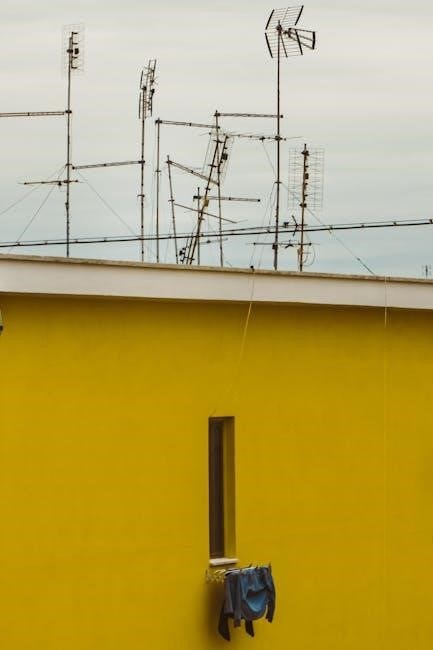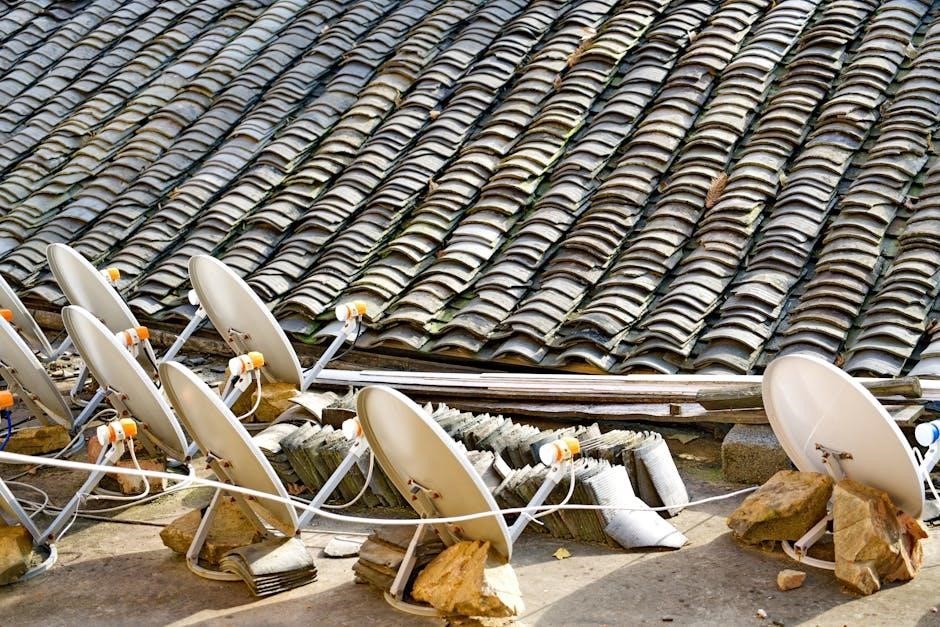Antenna TV provides free access to local channels, sports, and news by using an antenna, offering a cost-effective alternative to cable or satellite services.
1.1 What is Antenna TV?
Antenna TV, or over-the-air (OTA) television, allows viewers to receive free broadcast channels by using an antenna. It provides access to local networks, sports, and news without subscription fees. Unlike cable or satellite services, Antenna TV relies on signals transmitted through the air, offering high-definition (HD) quality. This method is cost-effective and eliminates monthly payments, making it a popular choice for cord-cutters. In Tulsa, residents can enjoy major networks like ABC, CBS, FOX, and NBC, along with local programming and community channels. Antenna TV is a simple, reliable way to stay entertained and informed, perfect for those seeking affordable, high-quality television options.
1.2 Evolution of Over-the-Air TV
Over-the-air (OTA) television has undergone significant advancements since its inception in the mid-20th century. Initially, broadcasts were analog-based, offering limited channels and reception quality. The transition to digital TV in the 2000s marked a major milestone, enhancing picture quality and enabling multiple sub-channels. This shift allowed for high-definition (HD) broadcasts and expanded programming options. The digital transition in 2009 further solidified OTA TV’s role in providing free access to content. Today, modern antennas can capture HD and even 4K signals, offering viewers a cost-effective, high-quality alternative to paid services. The rise of cord-cutting has revitalized interest in OTA TV, with viewers in Tulsa and beyond benefiting from its reliability and diversity of channels. This evolution ensures OTA TV remains relevant in the digital age, blending tradition with cutting-edge technology.

Benefits of Using an Antenna
Using an antenna provides free access to local channels, sports, and news in high definition, eliminating monthly subscription costs and offering reliable over-the-air TV reception.
2.1 Cost-Effective Option
Using an antenna is a highly cost-effective way to access TV channels in Tulsa. It eliminates the need for expensive cable or satellite subscriptions, providing free over-the-air programming. With no monthly fees, viewers can save hundreds of dollars annually while still enjoying major networks, local news, and sports. The initial investment in an antenna is minimal, making it a budget-friendly solution for those looking to cut costs without sacrificing entertainment. Additionally, many antennas offer high-definition reception, ensuring a crisp and clear viewing experience. This makes antenna TV an attractive option for cord-cutters seeking affordable and reliable access to their favorite channels in the Tulsa area.
2.2 Access to Local Channels
One of the key benefits of using an antenna in Tulsa is gaining access to local channels. These channels provide a wide range of programming, including news, sports, weather updates, and community events specific to the Tulsa area. With an antenna, you can receive signals from major networks like ABC, CBS, FOX, NBC, and PBS, ensuring you stay connected to local happenings. Additionally, many antennas can pick up sub-channels, offering even more variety in programming. This feature is particularly valuable for residents who want to stay informed about local issues or enjoy regional sports coverage without relying on cable or satellite services. The ability to access these channels for free makes antenna TV a practical choice for viewers in Tulsa.

How to Choose the Right Antenna
Selecting the right antenna for Tulsa involves considering location, signal strength, and channel availability. Indoor or outdoor options are chosen based on distance from broadcast towers.
3.1 Types of Antennas
Antennas come in various types, each designed for specific needs. Indoor antennas are compact and suitable for urban areas, while outdoor antennas offer stronger signals and are ideal for rural or suburban locations. Directional antennas focus on signals from a specific direction, enhancing reception from distant towers. Omnidirectional antennas, on the other hand, receive signals from all directions, providing broader coverage but with less intensity. Additionally, amplified antennas are available to boost weak signals, ensuring clearer reception in areas with obstructions. Choosing the right type depends on your location, the strength of available signals, and the channels you wish to access in Tulsa.
3.2 Factors Affecting Antenna Range
The range and effectiveness of an antenna in Tulsa are influenced by several factors. Physical location plays a crucial role, with hills, tall buildings, and trees potentially blocking signals. The distance from the broadcast towers also impacts reception, as signals weaken over longer distances. Additionally, the type and quality of the antenna itself determine its ability to capture signals. Interference from electronic devices and nearby structures can further degrade signal strength. In Tulsa, choosing the right antenna and placing it in an optimal location, such as a higher elevation or outdoor area, can significantly improve reception. Understanding these factors helps ensure access to a wide range of channels and a clearer viewing experience.
3.3 Directional vs Omnidirectional Antennas
Choosing between directional and omnidirectional antennas is crucial for optimizing TV reception in Tulsa. Directional antennas are designed to receive signals from a specific direction, making them ideal for areas where broadcast towers are concentrated in one location. They often provide stronger signal strength and better reception quality. On the other hand, omnidirectional antennas receive signals from all directions, offering flexibility for those who want to capture channels from multiple broadcast locations. However, they may be more susceptible to interference and have a shorter effective range compared to directional models. In Tulsa, where broadcast towers are spread out, a directional antenna might be preferable for clearer and more reliable reception, especially in areas with obstacles like hills or buildings.

Installation Guide
Install your antenna in a high, obstacle-free location for optimal signal reception. Use necessary tools like a coaxial cable and signal amplifier for strong channel clarity.
4.1 Step-by-Step Installation Process
Begin by choosing an ideal location for your antenna, preferably outdoors or in an attic, to maximize signal strength. Mount the antenna securely and connect it to your TV using coaxial cable. Ensure all connections are tight and undamaged. Next, perform a channel scan using your TV’s built-in tuner to detect available channels. For optimal reception, adjust the antenna’s position and angle to minimize obstructions. If needed, install a signal amplifier to boost weak signals. Finally, test the picture quality and make necessary adjustments to achieve the best viewing experience in the Tulsa area.
4.2 Best Locations for Antenna Placement
For optimal reception in Tulsa, place your antenna in a location with minimal obstructions, such as a high elevation or near a window facing the direction of broadcast towers. Outdoor antennas typically perform best, mounted on rooftops or in open spaces. Indoor antennas can work well if placed near a window or in an attic. Avoid areas with metal obstructions, as they can weaken signals. If living in a mobile home, consider outdoor placement to maximize signal strength. Attics are ideal for indoor antennas, as they provide protection while maintaining decent reception. Higher elevations reduce interference from trees or buildings, ensuring clearer channel access in the Tulsa area.
4.3 Necessary Tools and Materials
To successfully install an antenna for Tulsa TV channels, you’ll need a few essential tools and materials. Start with a high-quality antenna designed for your specific needs, along with a coaxial cable to connect it to your TV. A signal meter or digital tuner can help optimize reception. For outdoor installations, include a sturdy mounting bracket and J-pole or mast for secure placement. Pliers and a screwdriver are handy for connecting cables and adjusting the antenna. If wiring through walls, consider RG-6 coaxial cable for better signal strength. Zip ties or adhesive mounts can organize cables neatly. For safety, use a ladder and gloves when installing outdoors. Optional items like a signal amplifier or splitter may enhance performance in weak-signal areas. Ensure all materials are weatherproof for durability.

Channel Lineup in Tulsa
Tulsa offers a diverse range of channels, including major networks like ABC, CBS, FOX, NBC, and PBS, plus local stations like CW and MyNetworkTV, and special interest channels.
5.1 Major Networks Available
In Tulsa, major networks such as ABC, CBS, FOX, NBC, and PBS are readily available through antenna TV. These networks provide a wide variety of programming, including national news, sports, entertainment, and primetime shows. Viewers can enjoy popular programs like ABC’s Grey’s Anatomy, CBS’s 60 Minutes, FOX’s The Simpsons, NBC’s Sunday Night Football, and PBS’s educational content. These channels are broadcast in high definition, ensuring a crystal-clear viewing experience. Additionally, many of these networks offer sub-channels, such as MeTV and Cozi TV, which feature classic shows and movies. With an antenna, Tulsa residents can access these major networks for free, eliminating the need for expensive cable or satellite subscriptions. This makes antenna TV a cost-effective and reliable option for staying entertained and informed.
5.2 Local and Community Channels
Tulsa’s antenna TV offerings include a variety of local and community channels that cater to regional interests. Channels like KJRH (NBC), KTUL (ABC), and KOED (PBS) provide local news, weather, and sports, keeping viewers informed about Tulsa-specific events. Community-focused channels such as KMYT (MyNetworkTV) and KQCW (The CW) offer entertainment, syndicated shows, and local programming. These channels often feature high school sports, community events, and cultural programs unique to the Tulsa area. Additionally, some antennas may pick up religious and educational channels, adding to the diverse lineup. These local channels not only provide free entertainment but also connect viewers to their community, making antenna TV a valuable resource for staying informed and engaged locally.
5.3 Special Interest Channels
Tulsa antenna TV also offers a range of special interest channels catering to diverse viewer preferences. These include educational channels like PBS, which broadcasts documentaries, educational programs, and children’s content. Religious channels such as Daystar and TBN provide spiritual programming for faith-based audiences. Additionally, niche channels like MeTV and Antenna TV focus on classic TV shows, retro movies, and nostalgic entertainment. Sports enthusiasts can enjoy local and regional sports channels, while outdoor enthusiasts might appreciate channels dedicated to hunting and fishing. These special interest channels enhance the viewing experience by offering content tailored to specific audiences, making antenna TV a versatile option for a wide range of interests.

How to Scan for Channels
Modern TVs feature built-in scanning tools to detect over-the-air channels. Access the menu, select “Channel Scan,” and follow prompts to find available channels in Tulsa.
6.1 Built-in TV Scanning Features
Most modern TVs come equipped with built-in channel scanning features to easily detect over-the-air signals. To access this feature, navigate to your TV’s settings menu. Look for options labeled “Channel Setup,” “Broadcast,” or “Antenna.” Once there, select “Scan for Channels” or “Auto-Tune” to initiate the process. The TV will automatically search for available channels in your area, including local networks like ABC, CBS, FOX, and NBC in Tulsa. This feature ensures a quick and seamless connection to free OTA content. After scanning, the TV will save the found channels, allowing you to enjoy your favorite shows without any additional setup. Regularly rescanning can also help update your channel lineup if new stations become available.
6.2 Tips for Successful Channel Scanning
For successful channel scanning, ensure your antenna is properly positioned in an area with minimal obstructions, such as near a window or outdoors. Use a signal amplifier if you live in an area with weak reception. Rescan for channels periodically to update your lineup, especially after moving the antenna or installing a new one. Check your TV’s firmware for updates to ensure optimal performance. Avoid interference from other electronic devices by placing them away from the antenna. Consult online resources or apps to identify the best channels available in Tulsa. By following these tips, you can maximize the number of channels received and enjoy a clearer viewing experience with your antenna TV setup.
Tips for Better Reception
Optimize antenna positioning, minimize obstructions, and use a signal amplifier for stronger signals. Ensure quality cables and avoid interference from nearby electronic devices for clearer reception in Tulsa.
7.1 Optimizing Antenna Positioning
Proper antenna placement is crucial for maximizing signal strength and channel clarity in Tulsa. Start by positioning the antenna near a window or on a high wall to minimize obstructions like furniture or walls. For outdoor antennas, consider installing on the roof or a tall pole to ensure better line-of-sight to broadcast towers. Indoor antennas should be placed away from electronic devices to avoid interference. Experiment with different locations and heights to find the spot with the strongest signal. Use the TV’s built-in signal meter to gauge reception quality. Small adjustments can make a significant difference in the number of channels received and overall viewing experience.
7.2 Avoiding Obstructions and Interference
To ensure optimal reception in Tulsa, minimize obstructions and interference sources. Physical barriers like buildings, trees, and hills can block or weaken signals. Indoors, walls, furniture, and electronic devices (e.g., cordless phones, microwaves) can interfere. Move antennas away from such obstructions and devices. Additionally, avoid placing antennas near metal objects or reflective surfaces, as they can cause signal reflection or loss. Use high-quality coaxial cables to reduce signal degradation and interference. If possible, position the antenna in an area with a clear line-of-sight to broadcast towers. Regularly check for software updates on your TV or tuner to ensure compatibility and optimal performance. These steps will help maintain a stable and clear connection for your antenna TV channels in Tulsa.
7.3 Using Signal Amplifiers
Signal amplifiers can significantly enhance your antenna TV experience in Tulsa by boosting weak signals. If you live far from broadcast towers or face signal obstruction, an amplifier helps overcome signal loss. Place the amplifier close to the antenna to maximize effectiveness. Inline amplifiers are ideal for long cable runs, while pre-amplifiers are suited for outdoor setups. Be cautious not to over-amplify, as it can cause interference. Choose an amplifier with a low noise figure for better performance. This ensures clearer reception of Tulsa’s local channels, such as NBC, CBS, and FOX. Regularly test signal strength after installation to optimize your setup. Amplifiers are a practical solution for maintaining strong, stable signals in challenging environments.
7.4 Importance of Quality Cables
Quality cables play a crucial role in ensuring optimal antenna TV reception in Tulsa. High-grade RG-6 or RG-11 coaxial cables minimize signal loss and interference, delivering clearer pictures and better sound. Cheap or damaged cables can degrade signal strength, leading to pixelation or no signal issues; Always use cables with proper shielding to block electromagnetic interference. Weatherproof cables are essential for outdoor antennas to withstand Tulsa’s varying weather conditions. Additionally, keep cables as short as possible to avoid signal degradation. Properly secure and route cables to prevent bends or tangles, which can disrupt signal flow. Investing in quality cables ensures a stable and high-quality viewing experience for your favorite Tulsa channels.

Troubleshooting Common Issues
Identify issues like poor reception or no signal by checking connections, antenna positioning, and signal strength. Adjustments or signal boosters may resolve common Tulsa antenna TV problems effectively.
8.1 Dealing with Pixelation and No Signal
Pixelation and no signal issues on antenna TV in Tulsa can be resolved by checking antenna connections, ensuring proper alignment, and verifying signal strength. Weak signals often cause pixelation, while obstructed paths or faulty cables may result in no signal. Use a signal strength meter to identify optimal antenna placement. If issues persist, consider installing a signal amplifier to boost reception. Ensure all cables are securely connected and undamaged. Re-scan for channels after adjustments to confirm improvements. Additionally, check for local broadcast outages or tower maintenance, as these can temporarily affect signal availability. Regularly inspecting the antenna for damage or interference from nearby structures can also help maintain stable reception. Addressing these factors ensures consistent access to Tulsa’s antenna TV channels.
8.2 Addressing Interference and Poor Reception
Interference and poor reception on antenna TV in Tulsa can be mitigated by identifying and eliminating sources of disruption. Common culprits include nearby electronic devices, such as Wi-Fi routers and cordless phones, which can interfere with signal quality. Relocating the antenna away from these devices often improves reception. Additionally, physical obstructions like trees, buildings, or hills can block signals. Installing an outdoor antenna in a higher location may help overcome these obstacles. Using a signal amplifier can also enhance weak signals. Regularly checking and replacing damaged or corroded cables ensures optimal signal transmission. Experimenting with different antenna positions and orientations can further refine reception quality, ensuring clear access to Tulsa’s local channels. Addressing these issues effectively restores a stable and high-quality viewing experience for antenna TV users in the area.

Adding Streaming Services
Integrate streaming services with antenna TV for enhanced entertainment options, combining live channels with on-demand content for a diverse viewing experience in Tulsa.
9.1 Popular Streaming Platforms
Popular streaming platforms like Netflix, Hulu, and Amazon Prime offer a wide range of on-demand content, complementing the live channels available through antenna TV in Tulsa.
9.2 Integration with Antenna TV
Integrating streaming platforms with antenna TV in Tulsa enhances your viewing experience by combining free over-the-air channels with on-demand content. Devices like Roku, Amazon Fire Stick, or Google Chromecast allow seamless integration, enabling you to switch between live TV and streaming services effortlessly. This setup provides access to a broader range of content, including movies, shows, and sports, while maintaining the cost-effectiveness of antenna TV. Popular services like Hulu Live TV or YouTube TV can even complement your antenna by offering additional channels and features. This hybrid approach ensures you never miss your favorite programs while keeping cable costs low. It’s a flexible solution for modern viewers seeking both live and on-demand entertainment.
Antenna TV offers a cost-effective, reliable way to enjoy local channels, sports, and news in Tulsa, making it a great alternative to expensive cable services.
10.1 Recap of Benefits
Antenna TV in Tulsa offers numerous benefits, including free access to local channels, sports, and news without subscription fees. It provides high-definition content and reliable service during power outages. With no monthly costs, it’s a cost-effective alternative to cable or satellite services. Additionally, antenna TV allows viewers to enjoy live events and local programming, enhancing overall entertainment options. Its simplicity and lack of contracts make it an attractive choice for budget-conscious households. Furthermore, it complements streaming services, offering a blend of free and paid content. Overall, antenna TV in Tulsa is a practical and economical way to stay connected to local media and entertainment.
10.2 Encouragement to Explore Antenna TV
Exploring antenna TV in Tulsa is a smart decision for anyone looking to cut costs and enhance their viewing experience. With a wide range of free channels, including major networks and local programming, antenna TV offers unparalleled value. It’s a great way to access live sports, news, and entertainment without monthly fees. Plus, the setup is straightforward, and modern antennas are designed to provide high-quality reception. Whether you’re a cord-cutter or simply looking to supplement your current setup, antenna TV is worth trying. Take the first step by scanning for channels and discovering the variety of content available. You might be surprised at how much you can enjoy for free!

